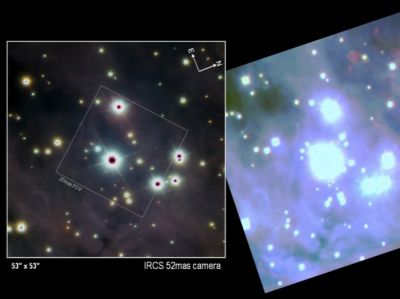It’s a gorgeous day in the mid-Atlantic states following one of the most colorful autumns in memory. Most of the leaves are down now, which gives me plenty to do. I had intended to look at the new paper from the California & Carnegie planet finder team, but the great outdoors beckons. Instead, we’ll examine their latest next week, along with more on interstellar flight scheduling with reference to Marc Millis’ recent presentation at Princeton and an intriguing Fred Hoyle insight.
For today, here’s a quick post on how adaptive optics can sharpen a telescope’s view. In the image below, you’re seeing two views of the part of the Orion Nebula known as the Trapezium. The Subaru telescope on Mauna Kea (Hawaii), working without adaptive optics, obtained the image on the right back in 1999. The image on the left shows the effect of a new laser guide star system and enhanced AO, and as you can see, the difference in detail is remarkable. Be sure to click to enlarge both views.
Image: The trapezium region in the Orion Nebula with and without adaptive optics. The image on the right has a resolution of 0.6 arcseconds and was obtained with Subaru’s CISCO camera in 1999 without the use of adaptive optics. The image on the left has a resolution of 0.06 arcseconds and was obtained in October 2006 using Subaru’s IRCS camera and the new adaptive optics system. Credit: Subaru Telescope/National Astronomical Observatory of Japan.
What we’re starting to see from Earth-based observatories would have astonished an earlier generation of astronomers. The new system greatly boosts Subaru’s capabilities over an earlier AO installation. Its laser guide creates an artificial star high in the atmosphere, the light from which can be measured to gauge atmospheric distortion. The adaptive optics system then adjusts the shape of its deformable mirror 1000 times a second to erase the extraneous effects — no more ‘twinkling’ star.
In essence, being able to produce an artificial ‘star’ for measurements anywhere in the atmosphere means that observing teams aren’t limited to regions near existing stars. They can observe any part of the sky they choose, and when they do lock onto a star or distant galaxy, the observatory’s new 188-element wavefront sensor improves Subaru’s view by a factor of ten. One thing’s for sure: if we ever do launch an interstellar probe, installations like these and upcoming space-based systems like Kepler and COROT will sharpen our view of its target.



The previous article talked about waiting for technlogy to provide higher speed interstellar travel. The comparison was made to computers gaining speed. Here’s another analogy.
We’ve been talking about adaptive optics for twenty years. This year, the Keck II is doing routine laser aided adaptive optics. Keck I ought to be doing it routinely next year. The VLT is getting it. Now Subaru. And, you’d think that projects requiring high resolving power, like resolving the disk of any star other than the Sun, would simply wait. But, the VLT completed just such a project without adaptive optics. The size of Proxima Centuri has been directly measured. It turns out that you can get better data by taking alot of it. You get improvement with the square root of the number of observations. So, by trying real hard, you can get better results.
The Hiparcos astrometry space mission did this too. This scope had a small diameter primary mirror. It was something like 14 inches across. The diffraction limit was something like 200 milliarc seconds. Yet, the mission results include precisions of 2 to 4 milliarc seconds for over a million objects. How was this done? With hard work. By comparison, the HST has a primary mirror over 2 meters in diameter. The diffraction limit is something like 50 milliarc seconds. In 20 minutes, the Fine Guidance Sensors can obtain a 3 milliarc second lock on a star. With hard work, the HST has achieved 200 microarc second precision, enabling it to detect the side to side wobble of a star due to the effects of an orbiting body.
Astronomers can’t be lazy. They currently have to do things the instant they are feasible.
Now that several ground based scopes are getting a factor of ten improvement in precision, i can hardly wait for some astounding hard-work results. Not just pretty pictures.